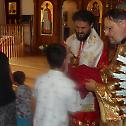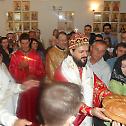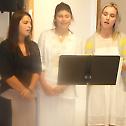A brief history of Portland Parish
Orthodox Christian organized church life in Portland, Oregon began in the 1890s with the arrival of Archimandrite Sebastian Dabovic, Serbian Orthodox Apostle to America. A missionary priest for California and the Pacific Northwest, Archimandrite Sebastian visited local Christian Orthodox families in Portland where he founded the first Orthodox Christian chapel dedicating it in the name of the “Holy and Life-giving Trinity”. The chapel was consecrated on February 26, 1895 and liturgical services were conducted from 1895 to 1926. After the church was founded, Father Sebastian would travel to Portland to perform the Holy Liturgy for two consecutive years. At that time, the small congregation consisted of six Syrians, four Serbs, and two Russians.
Portland is a city located in the U.S. state of Oregon, near the confluence of the Willamette and Columbia rivers. As of the 2010 Census, it had a population of 583,776, estimated to have reached 587,865 in 2012 making it the 28th most populous city in the United States. Portland is Oregon’s most populous city, and the third most populous city in the Pacific Northwest region, after Seattle, Washington, and Vancouver, British Columbia. Approximately 2,289,800 people live in the Portland metropolitan area (MSA), the 19th most populous MSA in the United States.
Portland was incorporated in 1851 near the end of the Oregon Trail and is the county seat of Multnomah County. The city has a commission-based government headed by a mayor and four other commissioners as well as Metro, a distinctive regional government. The city is noted for its superior land-use planning and investment in light rail. Because of its public transportation networks and efficient land-use planning, Portland has been referred to as one of the most environmentally friendly, or “green”, cities in the world.
Located in the Marine west coast climate region, Portland has a climate marked by both warm, dry summers and wet, cool-to-chilly winter days. This climate is ideal for growing roses. For more than a century, Portland has been known as the “City of Roses”, with many rose gardens—most prominently the International Rose Test Garden. The city is also known for its abundant outdoor activities, liberal political values, and beer and coffee enthusiasm. Portland is home to a collection of independent microbreweries, microdistilleries and food carts that contribute to the unofficial but widely utilized [citation needed] slogan “Keep Portland Weird”.
However, it was not until the 1990s that a Serbian Orthodox Christian parish was established. In the fall of 1991, a group of Orthodox Serbs goes to St. Sava Church in Isaquah, Washington where they attend the Sunday Liturgy and discuss with Father Lavrentije Janjic about a renewal of the Serbian Orthodox Church in Portland. Father Lavrentije comes to Portland on several occasions with a goal to re-establish the Serbian Orthodox Church in Portland. On September 13, 1991, the founding meeting was held at the Holy Trinity Greek Orthodox Church in Portland which was attended by 20 people, these being united in creating Serbian church in Portland. At the beginning, it was necessary to decide if there was an actual need for a Serbian church there since a large number of Serbian people either attended services at St. Nicholas-the Russian Orthodox Church , or at the Holy Trinity Orthodox Church in Portland. Most of the people present in the meeting agreed that a Serbian Orthodox church should be re-established. Thus, on September 21, the same year, at the second founding meeting Father Lavrentije re-establishes the Serbain parish in Portland and dedicates it to the Nativity of the Most Holy Mother of God.
The first liturgical service was held on October 19, 1991 in the Holy Trinity Greek Orthodox Church. It was performed by Father Lavrentije and the liturgical responses were given by the choir from St. Sava Church from Seattle. The service was followed by a banquet and a Church Board meeting in the church social hall where it was decided that the Holy Liturgy would be held on Saturdays at St. Nicholas Russian Orthodox Church in Portland.
The Second Liturgy was held on November 1991 at St. Nicholas Russian Orthodox Church. The same year, His Grace Bishop Hrizostom, Administrator of Western Serbian Diocese in America visits Portland. During this period of time, various liturgical services were held in different houses and in the house backyards of Serbian families. The first church newsletter was written and sent to church members, while many picnics, and church funds were organized in support of the Serbian families affected by war in former Yugoslavia. Father Lavrentije suggested that in order for the new church to be built there should be at least five families willing to provide the support, to file for tax exemption status, and to obtain non-profit status. In this period church members collected $16,000 for Serbian Relief Found and $2,500 for North West Medical Team.
On February 11, 1995 Protopresbyters Dane Popovic and Budimir Andjelic performed the Liturgy at St. Nicholas Russian Orthodox Church in Portland. After the service, the Annual Church Assembly Meeting was held by Father Budimir who read out the letter from His Grace Bishop Jovan dated November 1994 in which the Bishop expressed his concern towards the then organization of the church and appointed Father Dane as Administrator of the church in Portland. In the Assembly Meeting, the name of the church was changed to St. Stephen the Protomartyr and a new board was elected.
Western Diocese of Serbian Orthodox Church in their letter dated September 4, 1995 informs the church about the upcoming visit of His Grace Bishop Jovan to Portland. After the Divine Liturgy, Father Dane introduces his Grace Bishop Jovan to the parishioners. During a banquet which followed the Liturgy, his Grace Bishop Jovan spoke about rekindling St. Stephen’s Church in Portland. During his speech, His Grace Bishop Jovan emphasized that separation from Church would also mean separation from life and suggested that the Church Board should implement some necessary changes. After the visit of His Grace Bishop Jovan to Portland, church activities were revived, the church newsletter was sent on monthly basis, while church services were held every month. The first Christmas Eve Vespers was performed by Father Miroslav Markovic, and the first St. Stephen’s Slava was held in the home of Milo Braic.
On January 20, 1996 the Church Board develops church bylaws which were to be adopted at Annual Church Assembly on February 17, 1996. With limited funding available, the discussions on the building of the new church and a full time priest begin.
The first Easter Service is held on April 27th of 1996, and is attended by 51 parishioners. The Church Board asks His Grace Bishop Jovan to assign a priest with a permanent position.
The indisputable Eucharistic character of Church structure, as it developed in the first three centuries, and subsequently confirmed in Church councils, meant anything but the subjection of the lay person to the higher authority in the manner of an earthly institution. On the contrary, it meant that there was a ministry called Episcopacy “through which the Church remained in the final analysis a concrete community.”
His Grace Bishop Jovan celebrated the Divine Liturgy after which the Church Board president Dragoslav Petrovic informed His Grace and the parishioners that there is $20,619.81 available on the church account and that the Church Board considers purchasing a site in Milwaukie, OR where a Korean church burnt down. After receiving a blessing from his Grace, Dusan Lukovic informs the parishioners about the new location of the church giving them details of land purchase. It was unanimously decided by the church assembly to proceed with the plan and the new church property was purchased on October 10, 1996 for $165,000.
Everyone worked together on clearing of what was left behind from the burnt Korean church. However, Gojko Jesic and Milos Djukanovic put most effort in rebuilding the church. Church parishioners cleared 593 tons of waste and got grounds ready for the construction. This effort saved church $100,000, the amount various demolition companies were asking for. Working together on this holy endeavour we became one large family. The church retained a Serbian architect Mrs. Milica Dedjer, who donated her time, and with the help of Mr. Brian Hanna, an Irish architect, lecturer at the Oxford School of Architecture and a British Columbia employee, as well as with Nikola Jankovic develops plans for the church construction.
The City of Milwaukie issues permits for the church construction and associated apartment buildings on June 3, 1997 after construction commences and gets completed in 2002.
On January 13, 1999 St. Stephen’s Parish receives its first priest, Father Dragan Zaric and his wife, Presbytera Teofana. Father Dragan serves until September 16, 1999. On October 18, 1998 His Grace Bishop Jovan baptized Mirko Draganic, who was the first baptized child in the newly re-established parish.
In 2002, the Church gets a new priest Father Miroslav Markovic with regular ministry.
On April 22, 2004 the Church receives a new priest, Father Nikola Todorovic, who with his impeccable service and involvement significantly advances the parish life.
In May 2005, the Church receives a new iconostasis from Serbia which was assembled on May 3, 2005.
Kolo Srpskih Sestara—Circle of Serbian Sisters—was formed and has been an indispensable part of our parish ever since. Likewise, thanks in large part to various members of the Circle of Serbian Sisters - the church choir, our Sunday School and our Foklore Dance group have played an important role in making our community stronger. Likewise, a soccer team was created to represent our church and has been very successful.
On October 2005 His Grace Bishop Longin, consecrates St. Stephen’s Church with the assistance of several other priests. After the consecration of the church and His Grace Bishop Maxim’s arrival to California, our parish starts to live a life of any other ordinary Serbian Orthodox Church in the United Sates of America.
In hope that together with the Western Diocese and the spiritual guidance of His Grace Bishop Maxim we will keep and perpetuate the Faith of our Forefathers, we send our warmest congratulations to his Grace Bishop Maxim, his monks and nuns, the priests and the faithful on the 50th Anniversary of Western Diocese.
Source: westsrbdio.org





